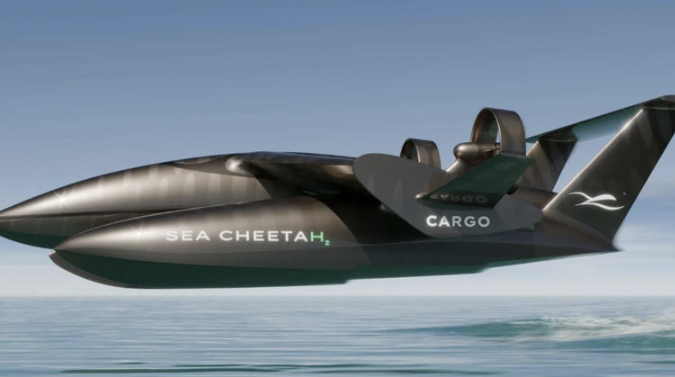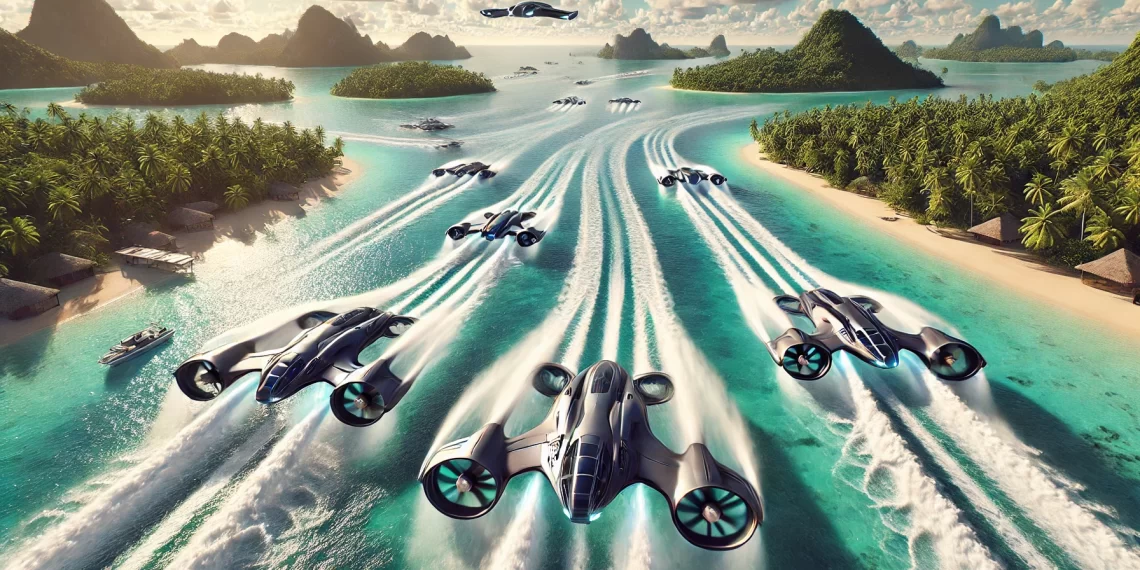Miami-based Sea Cheetah Corporation has taken a significant step forward in revolutionizing coastal and island transport by partnering with Toulouse-based H3 Dynamics, a company known for its expertise in hydrogen propulsion technologies. Together, the two companies are developing the world’s first hydrogen-electric wing-in-ground effect (WIGE) vessel, a craft that operates just above the surface of the water, drastically reducing travel times and operational costs for both commercial and potentially military applications.
WIGE vessels utilize ground effect to fly mere meters above the water’s surface, using aerodynamic lift to maintain flight. These vessels achieve speeds of over 135 knots (155 mph), significantly faster than traditional marine vessels, and offer the potential for rapid transport of passengers, cargo, and other essential supplies across coastal and island regions. This capability, paired with their high payload capacity and energy-efficient propulsion system, makes them ideal for connecting isolated or hard-to-reach areas.

The partnership with H3 Dynamics allows Sea Cheetah to push the limits of what WIGE vessels can achieve by incorporating hydrogen-electric propulsion. Hydrogen fuel cells are known for their efficiency and eco-friendliness, offering a cleaner alternative to fossil fuel-powered systems. By leveraging this technology, the companies aim to not only improve the fuel efficiency of WIGE vessels but also increase their range and payload capacity beyond what current battery-powered alternatives can provide.
This innovative approach to marine transport could also have profound implications for military operations, especially in the Indo-Pacific region. The Indo-Pacific, with its vast geography of scattered islands and challenging maritime routes, has long been a critical area of focus for U.S. and allied military forces. One of the greatest challenges in this region is intra-island mobility—how to move personnel, equipment, and supplies quickly and efficiently across the first island chain, which includes key territories like Japan, Okinawa, and the Philippines.
Currently, U.S. and allied forces rely on a combination of maritime and aerial assets to achieve this mobility, but these traditional options come with logistical hurdles, such as the need for extensive refueling, susceptibility to detection, and high operational costs. WIGE vessels, however, offer a unique solution. Their ability to operate just above the water’s surface allows them to combine the speed of air transport with the logistical ease of maritime operations, all while significantly reducing fuel consumption.
Imagine, for example, the mass production of these WIGE vessels—not just by the U.S., but also by key allies like Australia, Japan, the Philippines, and possibly even Malaysia. A fleet of 10,000 such vessels could be deployed across the Indo-Pacific, providing rapid-response mobility between islands. Some vessels could be manned, carrying personnel for small-unit maneuverability, while others could be unmanned, acting as cargo transports or decoys. This “cloud” of WIGE vessels, moving rapidly and unpredictably between islands, would create a highly flexible and resilient force, difficult for adversaries to track or target.
The military applications of this technology are vast. WIGE vessels could be used for a wide range of operations, from amphibious assaults and troop transport to logistical support and humanitarian aid. Their ability to fly just above the surface makes them difficult to detect by radar, offering an element of surprise that could be critical in a contested environment. Additionally, by operating at speeds much higher than traditional maritime vessels, they could provide faster responses to emerging threats or opportunities, allowing U.S. and allied forces to maintain a forward-deployed posture across the first and second island chains.
The environmental benefits of hydrogen-electric propulsion further enhance the strategic value of these vessels. By decentralizing the production of hydrogen fuel—using systems like the Sea Cheetah H2Hub and H2Hub Micro modules—forces could establish localized fueling stations in key areas, reducing the need for long and vulnerable supply lines. This would enable WIGE vessels to maintain a persistent presence in the region, operating with greater efficiency and fewer logistical constraints than conventional ships or aircraft.
Such capabilities are particularly important given the growing presence of China in the South China Sea and the broader Indo-Pacific. With Beijing increasingly asserting its influence over disputed territories and key maritime routes, the U.S. and its allies need innovative solutions to maintain freedom of navigation and ensure their forces can project power across this vast region. The ability to quickly move small units between islands, deliver supplies, and execute decoy operations with minimal detection could provide a significant tactical advantage in any potential conflict or standoff.
In addition to their military applications, these hydrogen-electric WIGE vessels also have immense potential for commercial transport. The vessels could be used for high-speed passenger ferries, cargo delivery, and even search-and-rescue operations, reducing the need for extensive port infrastructure while slashing operational costs. Their ability to fly just above the water and avoid aviation regulations simplifies the certification process and could speed up their entry into the market.
The potential for mass production of these vessels extends beyond just military operations. In the commercial sector, WIGE vessels could transform coastal and island economies by providing faster, more efficient transportation options that reduce reliance on traditional maritime vessels. This would be particularly valuable in regions where maritime routes are a lifeline for communities and industries. Moreover, the use of hydrogen-electric propulsion could help reduce carbon emissions, aligning with global efforts to combat climate change and promote sustainable transportation solutions.
As Sea Cheetah and H3 Dynamics continue to refine their hydrogen-electric propulsion system and expand the capabilities of WIGE vessels, it’s clear that this technology could reshape not only the future of maritime transport but also the strategic landscape of the Indo-Pacific region. Whether used for commercial or military purposes, these vessels represent a significant step forward in terms of speed, efficiency, and sustainability.
By integrating advanced hydrogen fuel cell technology with cutting-edge ship design, Sea Cheetah and H3 Dynamics are well-positioned to lead the charge in developing eco-friendly, high-speed transport solutions that can meet the evolving needs of both the commercial and military sectors. With their potential to provide rapid, flexible mobility in contested environments and reduce the logistical challenges of operating in the Indo-Pacific, hydrogen-electric WIGE vessels could prove to be a game-changer for U.S. and allied forces in the years to come.








